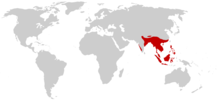King cobra
| King cobra | |
|---|---|
 |
|
| King cobra in Kaeng Krachan National Park | |
| Scientific classification | |
| Kingdom: | Animalia |
| Phylum: | Chordata |
| Class: | Reptilia |
| Order: | Squamata |
| Suborder: | Serpentes |
| Family: | Elapidae |
| Genus: |
Ophiophagus Gunther, 1864 |
| Species: | O. hannah |
| Binomial name | |
|
Ophiophagus hannah Cantor, 1836 |
|
 |
|
|
Distribution of the king cobra
|
|
| Synonyms | |
|
Genus-level:
|
|
Genus-level:
The king cobra (Ophiophagus hannah) is a species of venomous snake in the family Elapidae. The species is endemic to Asia, and is found predominantly in forests from India through Southeast Asia. This species is the world's longest venomous snake, with a total length (including tail) of up to 18.5 to 18.8 ft (5.6 to 5.7 m). Despite the word "cobra" in its common name, this snake is not a member of the Naja genus (the "true cobras"), which contains most cobra species, but the sole member of its own genus. It preys chiefly on other snakes and occasionally on some other vertebrates, such as lizards and rodents. The king cobra is a dangerous snake that has a fearsome reputation in its range, although it typically avoids confrontation with humans when possible.
The king cobra is a prominent symbol in the mythology and folk traditions of Pakistan, India, Sri Lanka and Myanmar.
Ophiophagus hannah belongs to the monotypic genus Ophiophagus in the family Elapidae, while most other cobras are members of the genus Naja. They can be distinguished from other cobras by size and hood. King cobras are generally larger than other cobras, and the stripe on the neck is a chevron instead of a double or single eye shape that may be seen in most of the other Asian cobras. Moreover, the hood of the king cobra is narrower and longer. A key to identification, clearly visible on the head, is the presence of a pair of large scales known as occipitals, located at the back of the top of the head. These are behind the usual "nine-plate" arrangement typical of colubrids and elapids, and are unique to the king cobra.
...
Wikipedia

